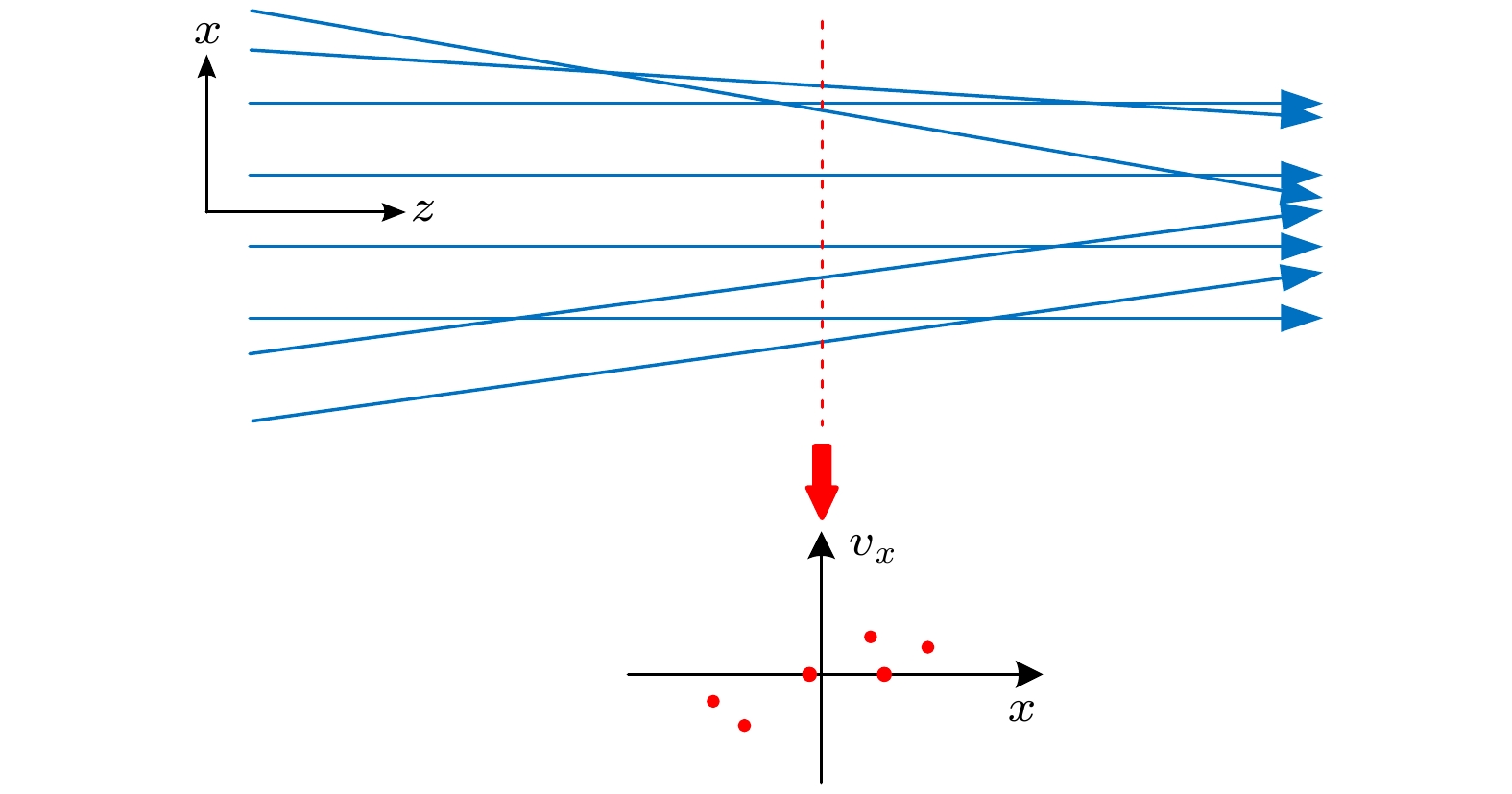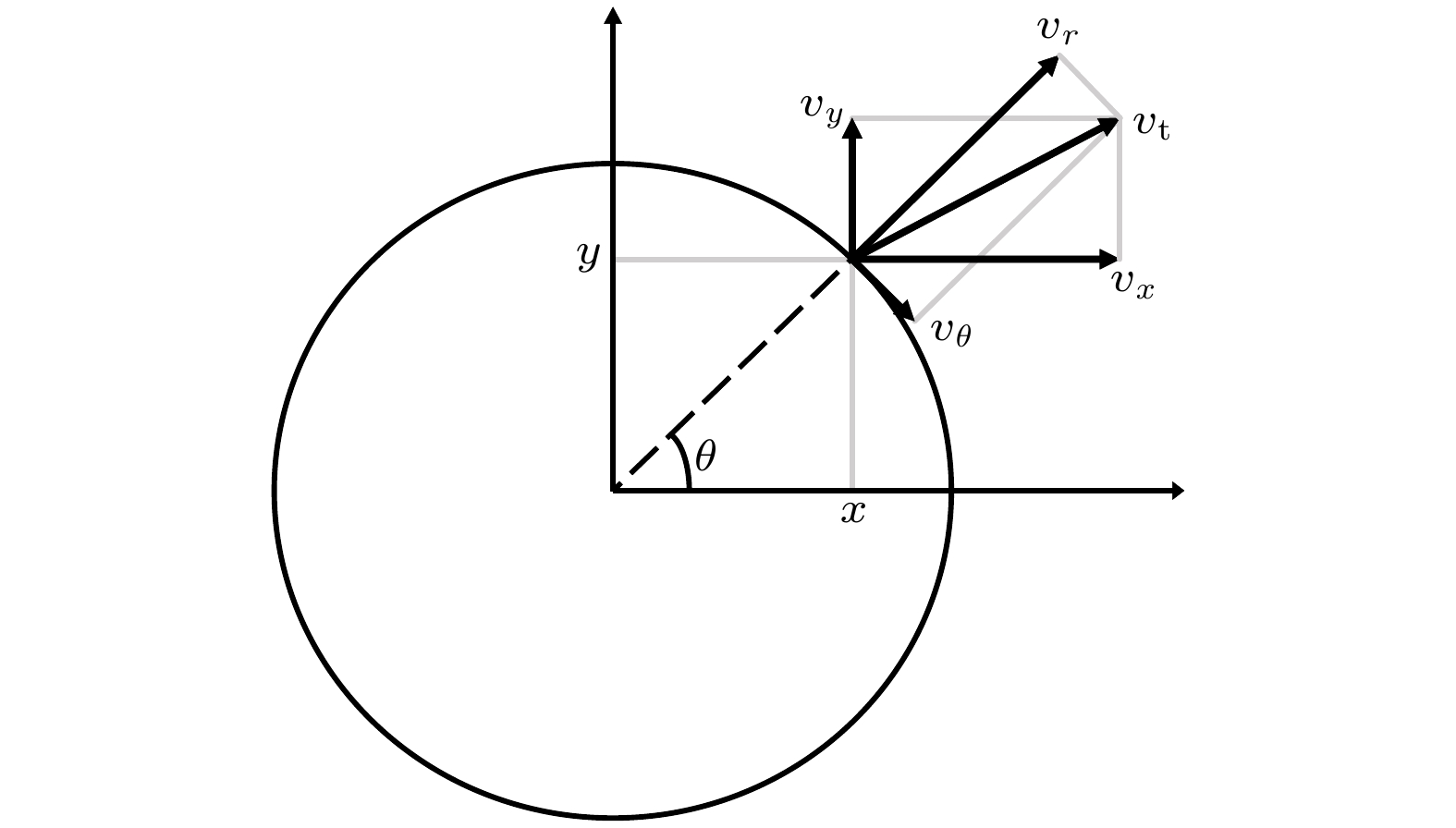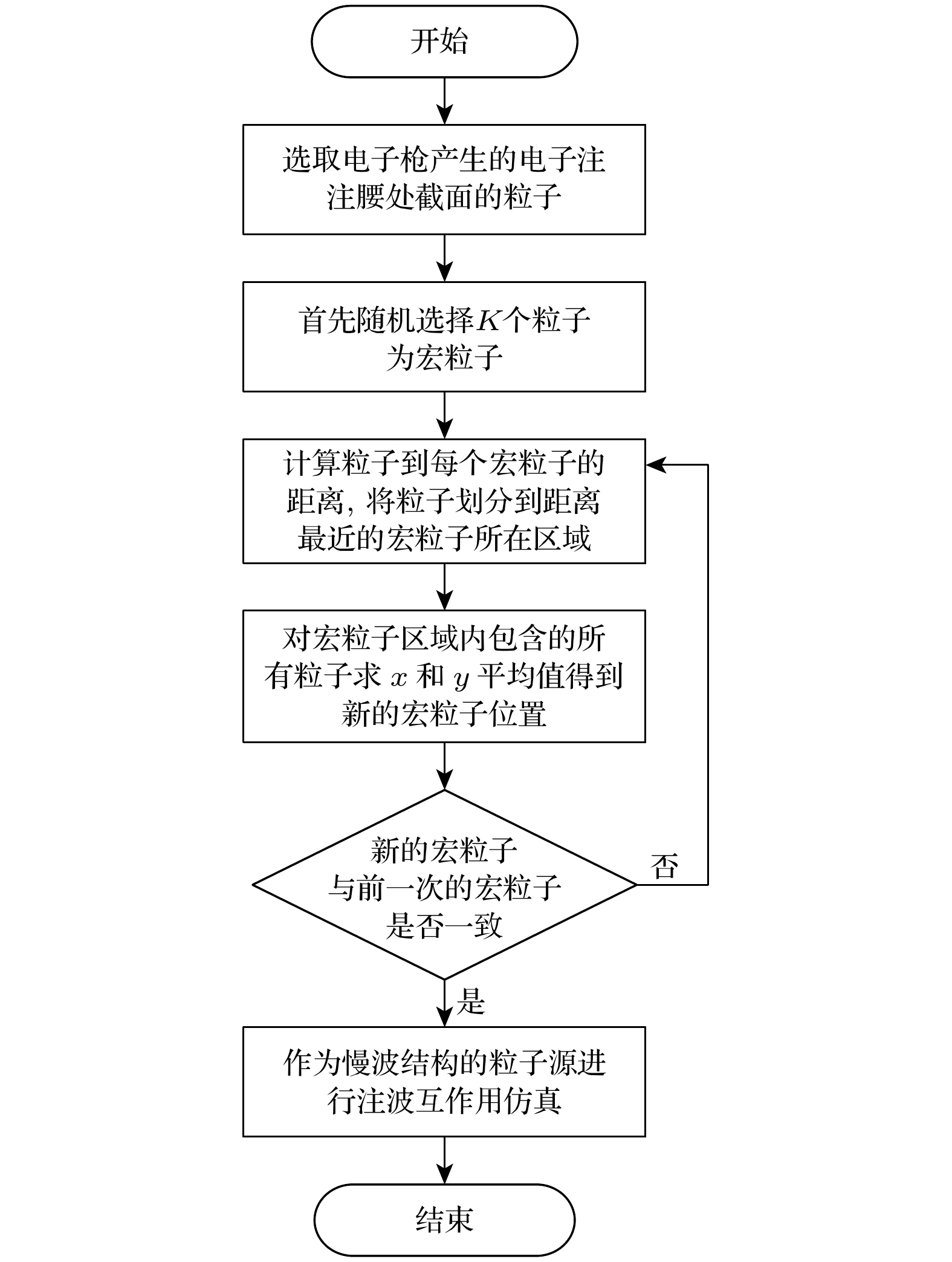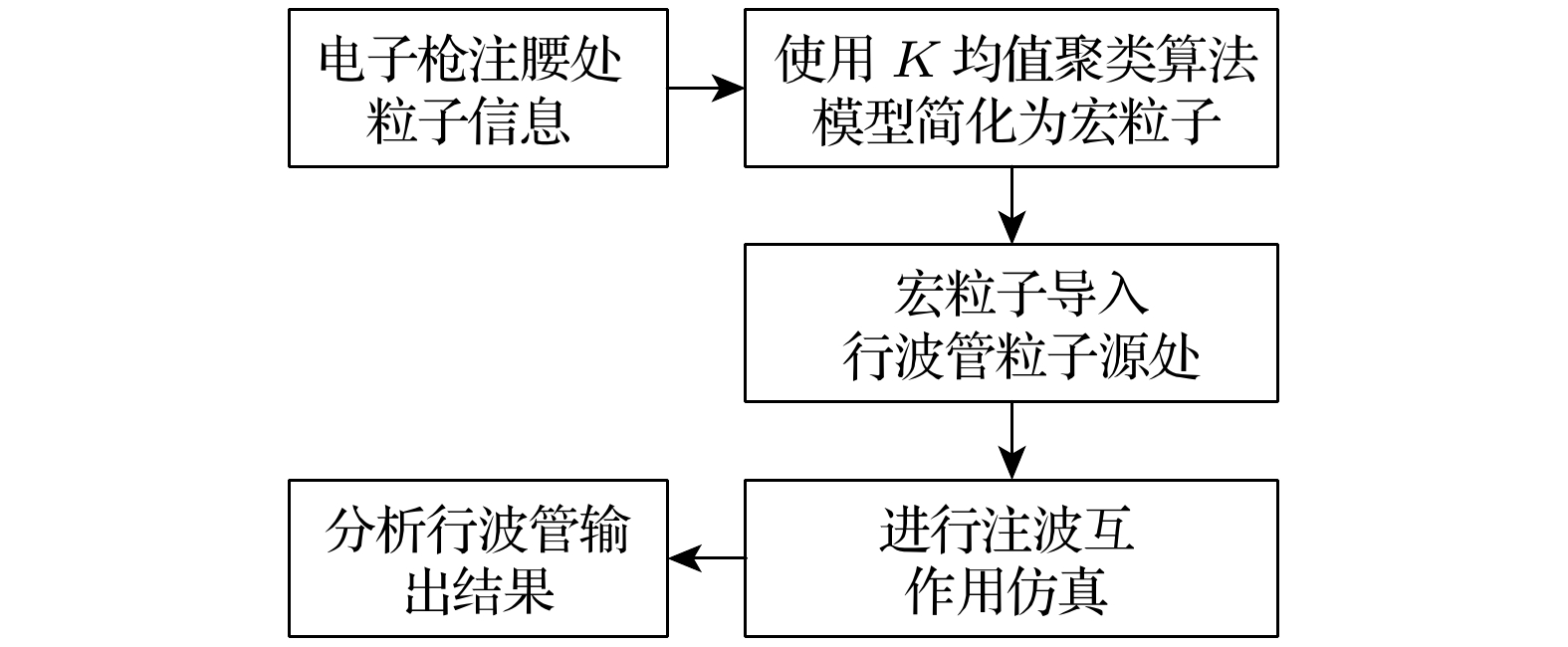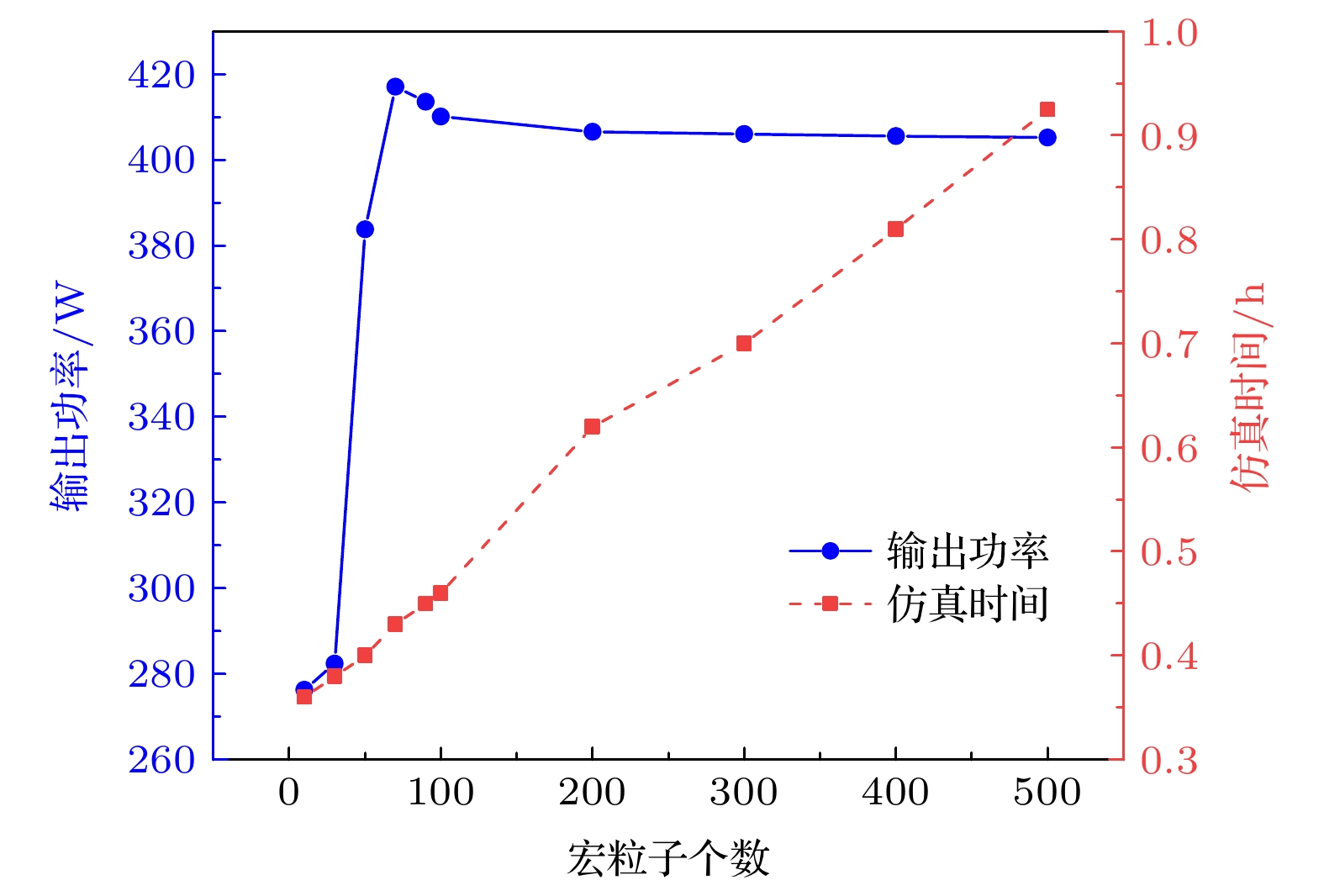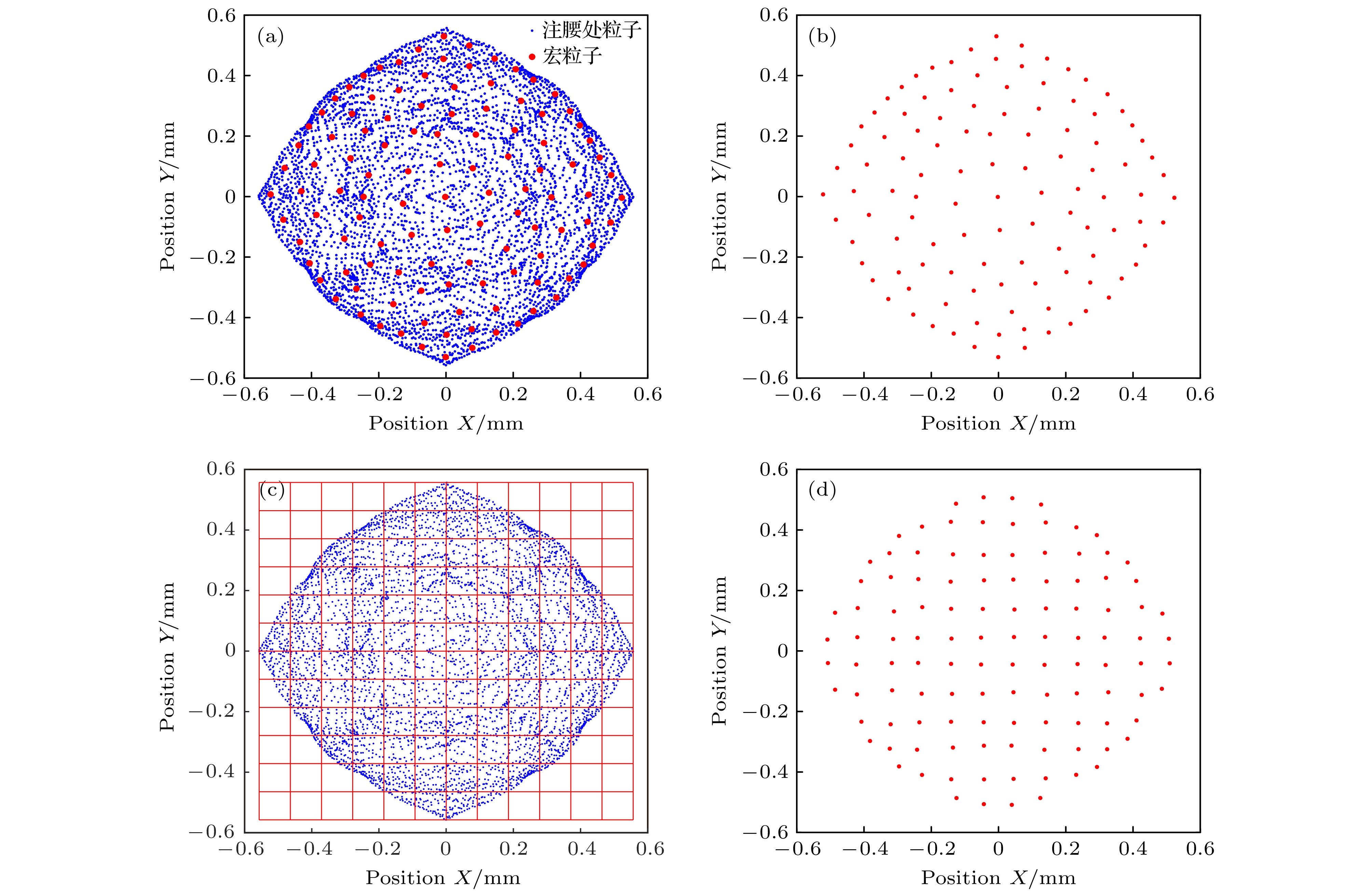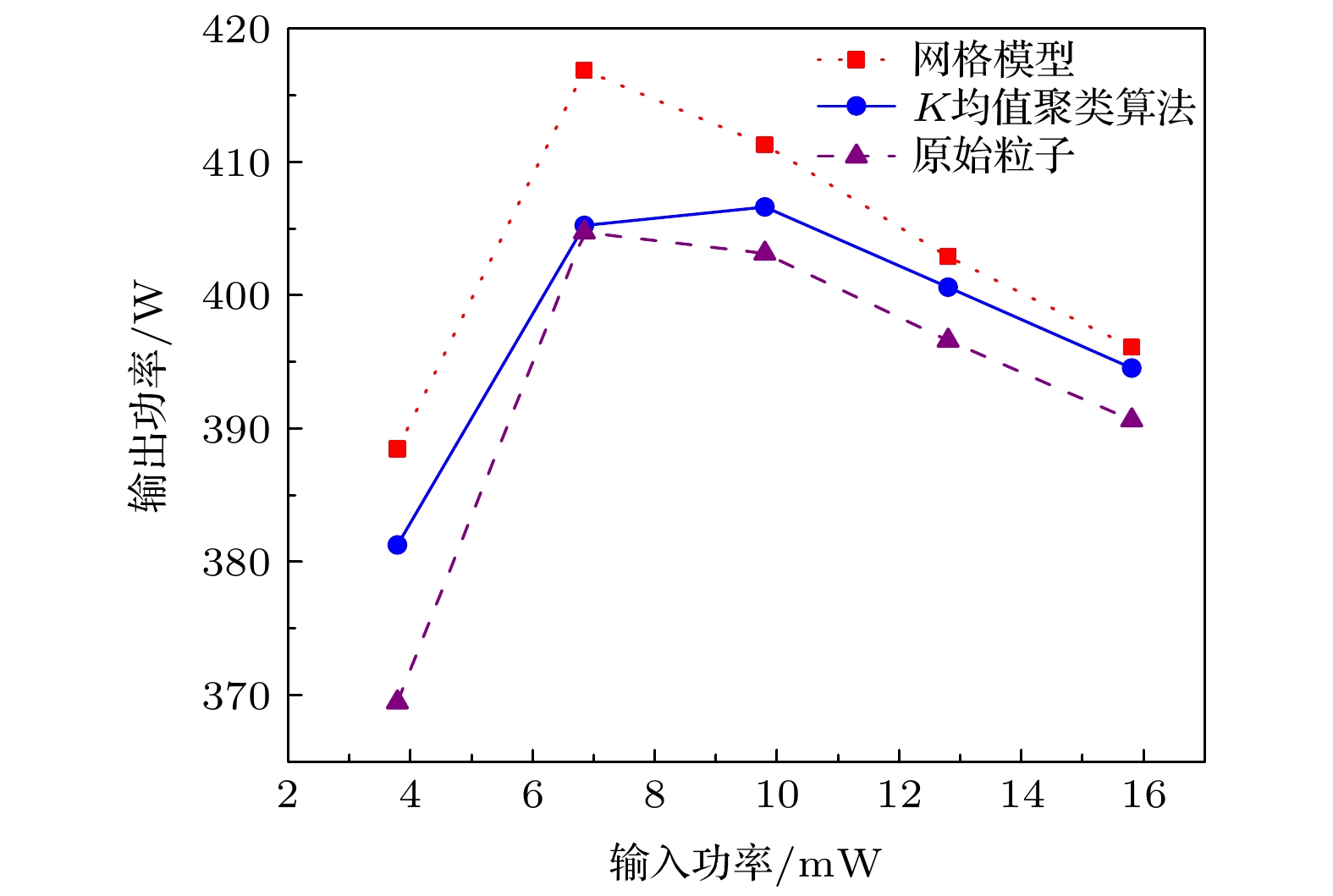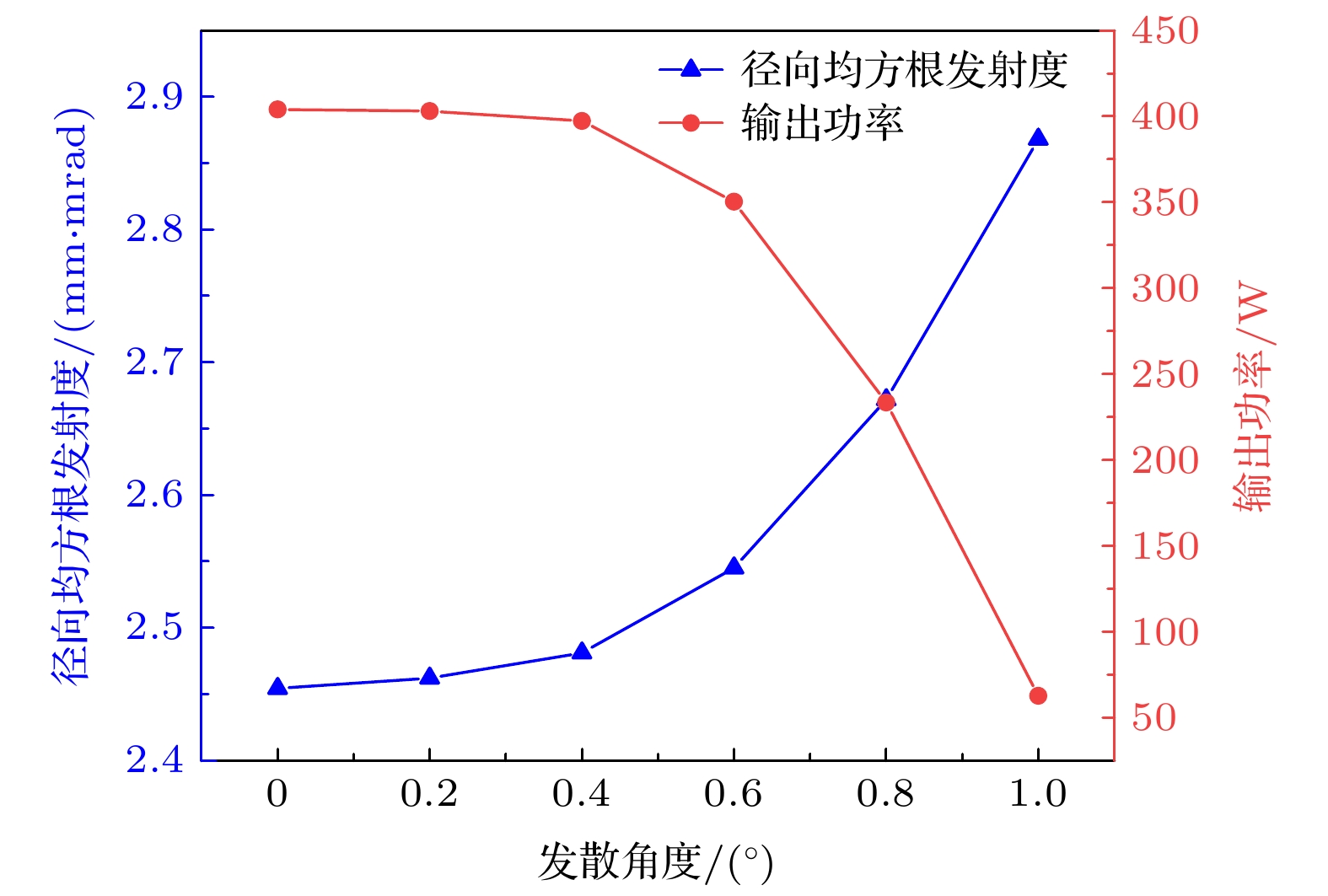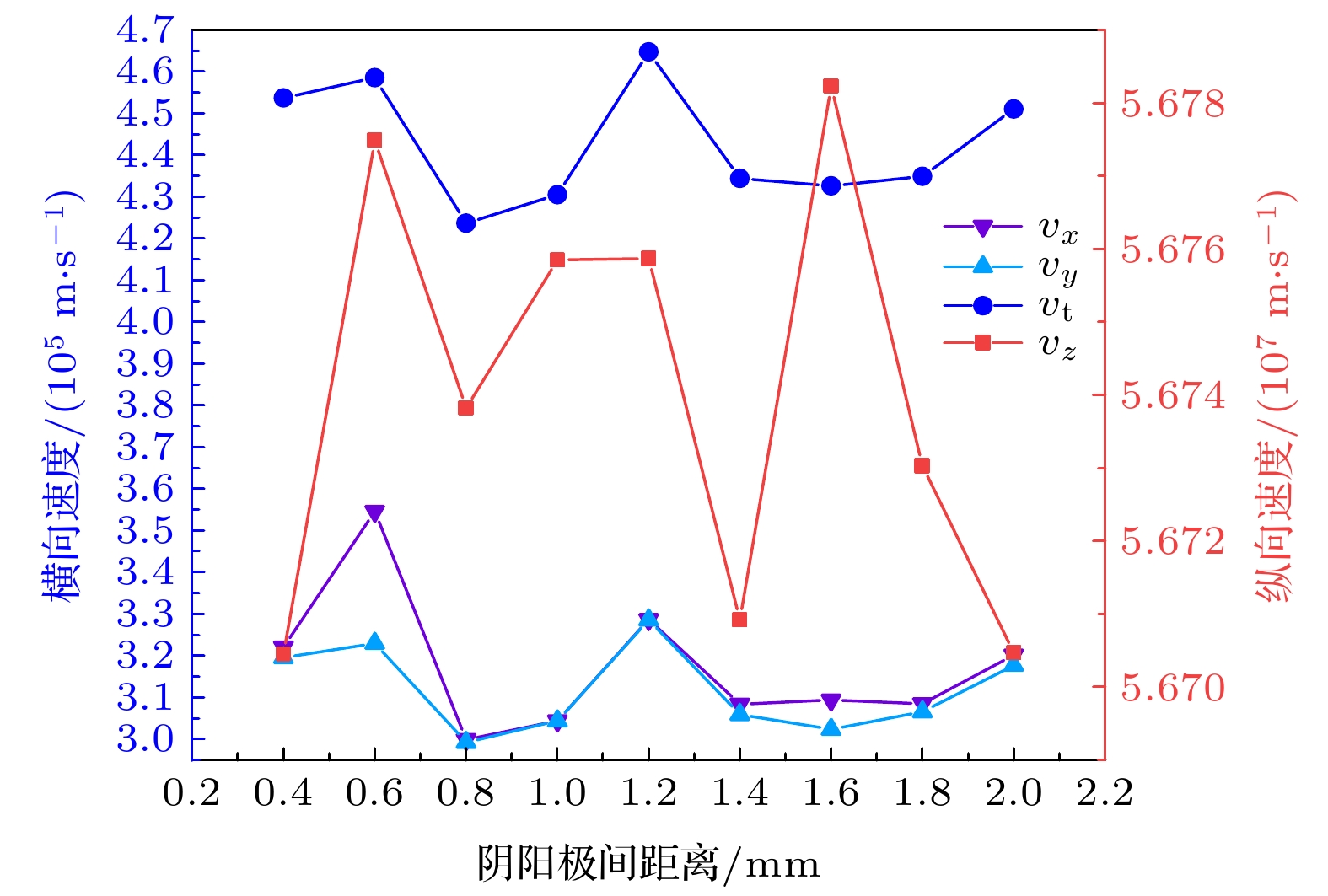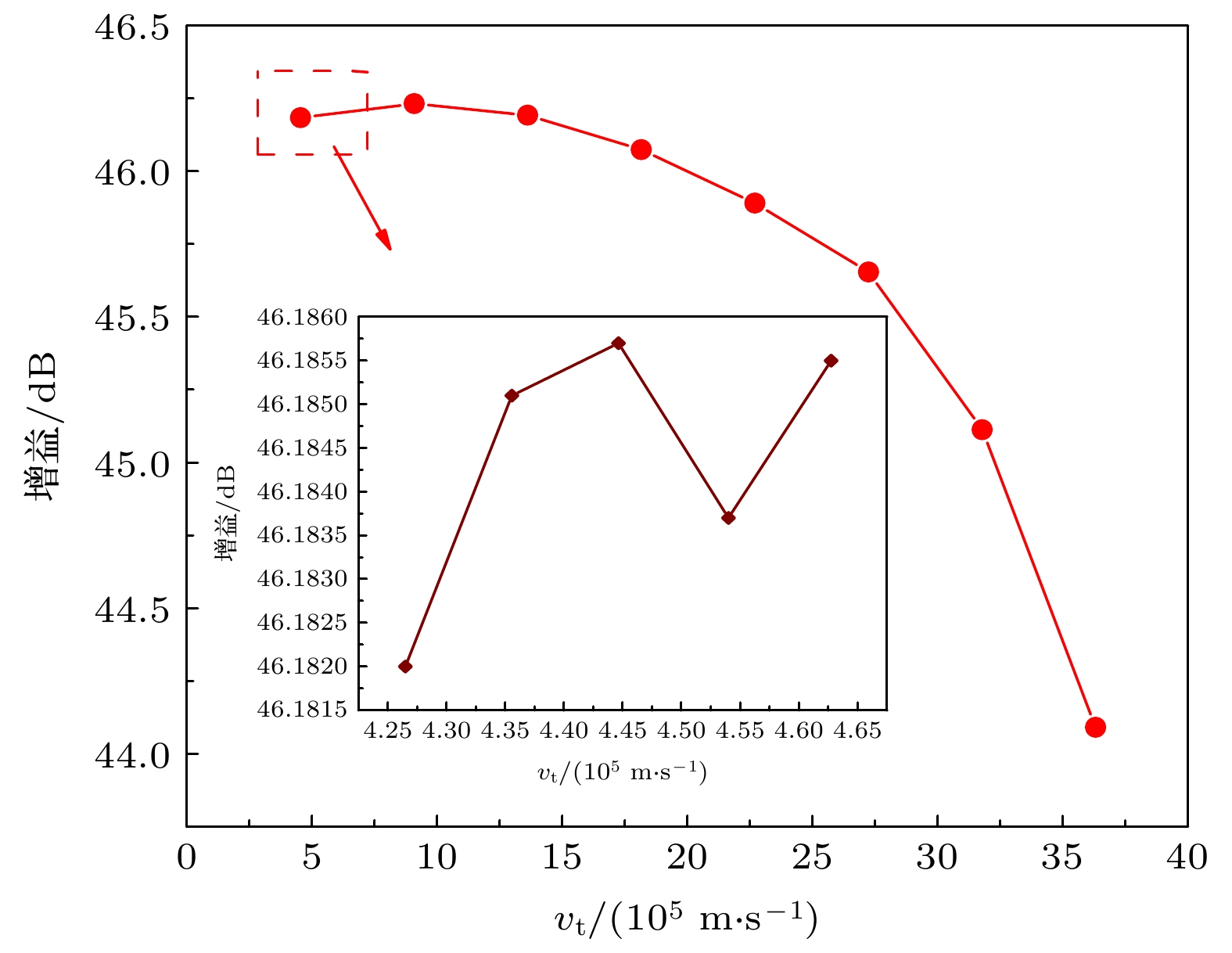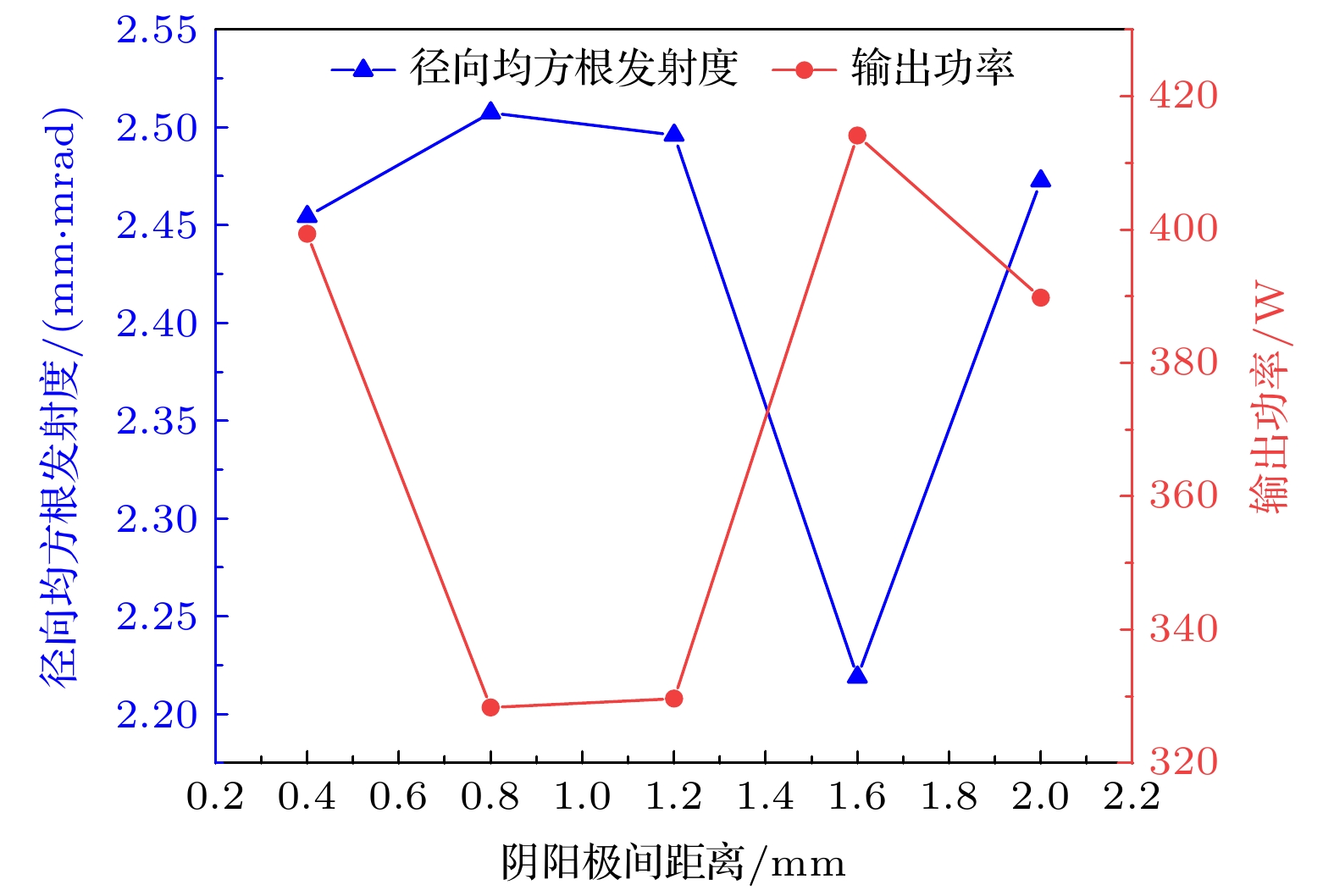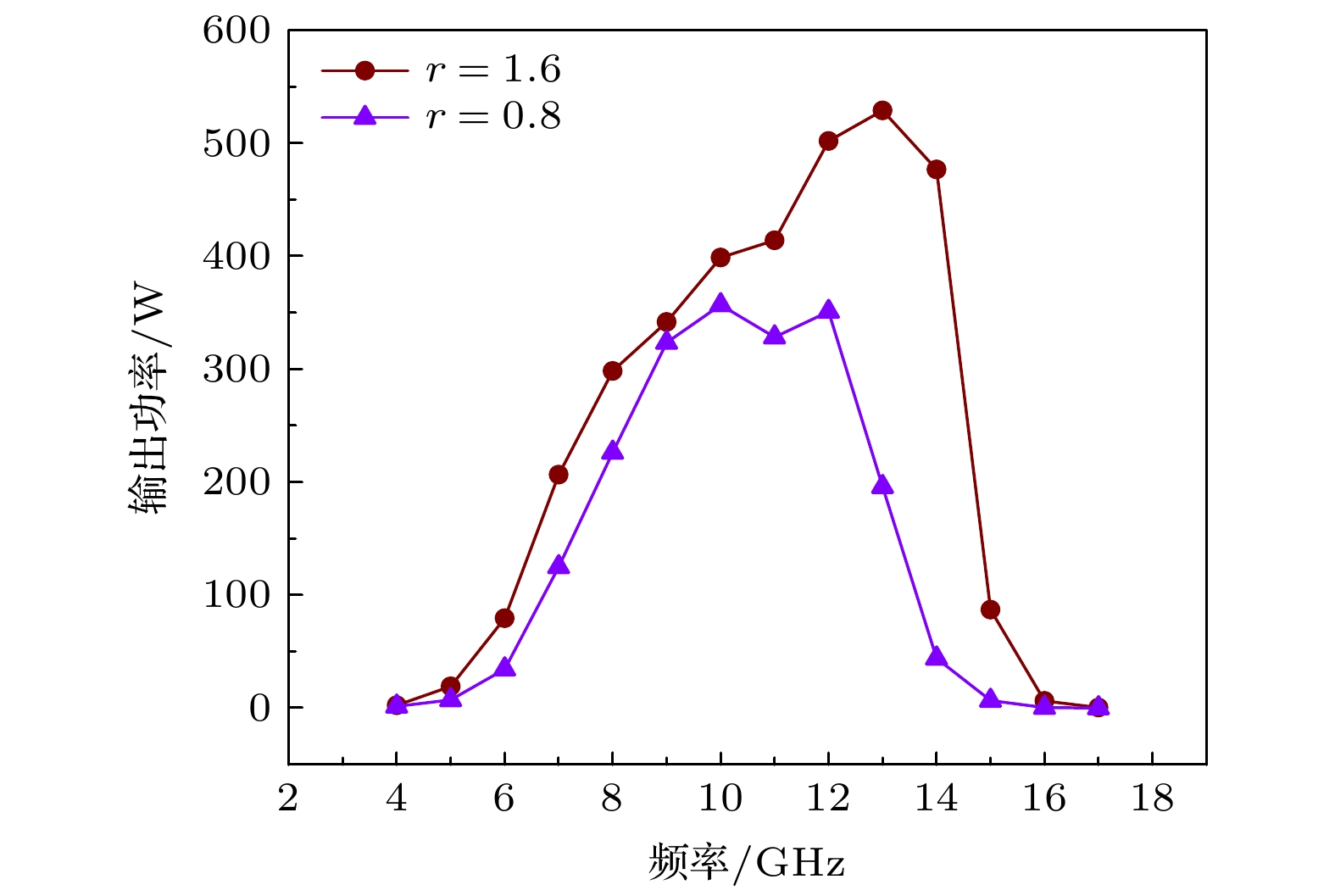-
为了提高行波管的稳定性和可靠性, 电子注的优化与设计成为真空电子器件中的关键部分, 层流性是评价电子注质量的关键参数. 提出使用K均值聚类算法将电子枪注腰处粒子简化为宏粒子的方法. 将该宏粒子作为行波管互作用区的粒子源进行注波互作用仿真, 使得仿真时间由5.53 h减少为0.65 h, 提高了仿真效率. 通过对某型号行波管的电子枪进行阴极发散角度和阴阳极间距离的调整. 仿真结果表明: 发散角度在0°—1°范围调节时, 发散角度越大, 径向均方根发射度数值也越大, 电子注层流性就越差, 行波管输出功率下降; 阴阳极间距离在0.8—1.6 mm范围内调节时, 径向均方根发射度由2.51 mm·mrad下降为2.22 mm·mrad时, 电子注的层流性得到改善, 空间行波管输出功率由328.34 W上升为414.10 W. 因此, 采用K均值聚类算法的粒子简化模型, 提升了注波互作用仿真效率, 依据电子注层流性对行波管性能的影响可以对电子枪结构参数优化.In order to improve the stability and reliability of the traveling wave tube (TWT), the optimization and design of the electron beam have become a key part in vacuum electronic devices. Laminar properties are a key parameter for evaluating the quality of the electron beam. The transverse displacement of the particles in the laminar electron beam is proportional to the transverse velocity. In the phase space distribution image of non-laminar properties electrons at a certain position, there is no linear relationship between the transverse displacement and the transverse velocity. The energies of particles in the electron beam are different, so the particles have different initial velocities. The particle source at the electron beam waist in the electron gun is used as a particle source for the beam wave interaction simulation. The output characteristics of the TWT more closely resemble the actual ones. A method of simplifying the particles at the electron gun beam waist into macroparticles using the K-means clustering algorithm is proposed. The macroparticle is used as a particle source in the TWT interaction zone for simulating the beam wave interaction, which reduces the simulation time from 5.53 to 0.65 h and improves the simulation efficiency. Compared with the original particle, both the simplified particle generated by the K-means clustering algorithm and the simplified particle generated by the mesh model greatly reduce the computational load of the interaction zone simulation. Compared with the results from the grid model, the simulation results of the beam-wave interaction of macroparticles, obtained by using the K-means clustering algorithm, are closer to those of the beam-wave interaction, obtained by using the original particles. By adjusting the cathode divergence angle and the distance between the anode and cathode of the electron gun of a certain type of TWT, the simulation results show that when the divergence angle is adjusted within a range of 0°–1°, the larger the divergence angle, the larger the radial root mean square emittance value, the worse the laminar properties of the electron beam, and the power of the output signal of the TWT decreases. When the distance between the anode and cathode is adjusted within a range of 0.8–1.6 mm, the radial root mean square emittance decreases from 2.51 to 2.22 mm·mrad, the laminar properties of the electron beam are improved. The output power of the TWT increases from 328.34 to 414.10 W, and the operating frequency bandwidth with an output power greater than 300 W is expanded from 3 to 5 GHz. Therefore, the particle simplification model using the K-means clustering algorithm improves the simulation efficiency of the beam wave interaction. Based on the influence of the laminar properties of the electron beam on the performance of the TWT, the structural parameters of the electron gun can be optimized.
-
Keywords:
- traveling wave tube /
- electron beam laminar property /
- K-means clustering algorithm /
- radial rms-emittance
[1] Guo Z, Zhang R, Lai H, Lan F, Wang Z, Lu Z 2023 IEEE Trans. Electron Devices 70 2753
 Google Scholar
Google Scholar
[2] 冯西贤, 缪国兴, 成红霞, 苏元盛, 罗川川 2024 第二十二届真空电子学学术年会 中国, 广州, 2024年5月9日 p2
Feng X X, Liao G X, Chen H X, Su Y S, Luo C C 2024 Proceedings of the 22nd Academic Conference on Vacuum Electronics Guangzhou, China, May 9, 2024 p2
[3] Pan R, Zhong C, Qian J 2024 IEEE Trans. Ind. Inf. 20 5914
 Google Scholar
Google Scholar
[4] Hou J, Zhang A 2020 IEEE Trans. Ind. Inf. 16 2477
 Google Scholar
Google Scholar
[5] Fang X, Xu Z, Ji H, Wang B, Huang Z 2023 IEEE Trans. Ind. Inf. 19 5476
 Google Scholar
Google Scholar
[6] Jiang Z, Lin R, Yang F, Wu B 2018 IEEE Trans. Ind. Inf. 14 1856
 Google Scholar
Google Scholar
[7] Jain A K 2010 Pattern Recognit. Lett. 31 651
 Google Scholar
Google Scholar
[8] Wang J, Shen C, Zhang J, Fan H, Bai N, Sun X 2023 International Vacuum Electronics Conference Chengdu, China, April 25–28, 2023 p1
[9] Carlsten B E, Nichols K E, Shchegolkov D Y, Simakov E I 2016 IEEE Trans. Electron Devices 63 4493
 Google Scholar
Google Scholar
[10] Ge X, Xu J, Yue L, Yin H, Zhao G, Wang W 2020 International Vacuum Electronics Conference Monterey, CA, USA, October 19–22, 2020 p237
[11] Shen C, Bai N, Zhang J, Sun X, Fan H 2019 International Vacuum Electronics Conference Busan, Korea (South), April 28–May 01, 2019 p1
[12] Louksha O, Trofimov P, Malkin A 2023 International Vacuum Electronics Conference Chengdu, China, April 25–28, 2023 p1
[13] Zhang J, Geng Z, Jin Q 2022 J. Phys. Conf. Ser. 2290 012030
 Google Scholar
Google Scholar
[14] David J, Ives R L, Tran H T, Bui T, Read M E 2008 IEEE Trans. Plasma Sci. 36 156
 Google Scholar
Google Scholar
[15] Liu W, Liu S 2011 Front. Electr. Electron. Eng. Chin. 6 556
 Google Scholar
Google Scholar
[16] Shen C, Wang J, Zhang J, Feng J, Sun X 2022 IEEE Trans. Plasma Sci. 50 2830
 Google Scholar
Google Scholar
[17] Lund S M, Kikuchi T, Davidson R C 2009 Phys. Rev. Spec. Top. Accel. Beams 12 114801
 Google Scholar
Google Scholar
[18] 赵国庆, 岳玲娜, 王文祥, 宫玉彬, 魏彦玉, 黄民智 2008 强激光与粒子束 20 1159
Zhao G Q, Yue L N, Wang W X, Gong Y B, Wei Y Y, Huang M Z 2008 High Power Laser Part. Beams 20 1159
[19] Stockli M P, Welton R F, Keller R 2004 Rev. Sci. Instrum. 75 1646
 Google Scholar
Google Scholar
[20] Whaley D R 2014 IEEE Trans. Electron Devices 61 1726
 Google Scholar
Google Scholar
[21] 李冬 2024 硕士学位论文(成都: 电子科技大学)
Li D 2024 M. S. Thesis (Chengdu: University of Electronic Science and Technology of China
-
图 7 使用K均值聚类算法和网格模型将电子枪注腰处粒子简化为宏粒子 (a) 使用K均值聚类算法处理截面粒子; (b) 使用K均值聚类算法简化后宏粒子分布; (c) 使用网格模型处理截面粒子; (d) 使用网格模型简化后宏粒子分布
Fig. 7. Particles at the waist of the electron gun are simplified into macroparticles by using the K-means clustering algorithm and the mesh model: (a) The cross-sectional particles are processed by using the K-means clustering algorithm; (b) the distribution of the macro particles after simplification by using the K-means clustering algorithm; (c) the cross-sectional particles are processed by using the mesh model; (d) the distribution of the macro particles after simplification by using the mesh model.
表 1 螺旋线行波管参数
Table 1. Parameters of helical TWT.
参数名称 参数值 工作电压/V 9600 工作电流/A 0.35 整管长度/mm 241.5 螺旋线螺距/mm 1.1 螺旋线半径/mm 1.0 螺旋线螺距角/(°) 9.9 磁场峰值/T 0.905 -
[1] Guo Z, Zhang R, Lai H, Lan F, Wang Z, Lu Z 2023 IEEE Trans. Electron Devices 70 2753
 Google Scholar
Google Scholar
[2] 冯西贤, 缪国兴, 成红霞, 苏元盛, 罗川川 2024 第二十二届真空电子学学术年会 中国, 广州, 2024年5月9日 p2
Feng X X, Liao G X, Chen H X, Su Y S, Luo C C 2024 Proceedings of the 22nd Academic Conference on Vacuum Electronics Guangzhou, China, May 9, 2024 p2
[3] Pan R, Zhong C, Qian J 2024 IEEE Trans. Ind. Inf. 20 5914
 Google Scholar
Google Scholar
[4] Hou J, Zhang A 2020 IEEE Trans. Ind. Inf. 16 2477
 Google Scholar
Google Scholar
[5] Fang X, Xu Z, Ji H, Wang B, Huang Z 2023 IEEE Trans. Ind. Inf. 19 5476
 Google Scholar
Google Scholar
[6] Jiang Z, Lin R, Yang F, Wu B 2018 IEEE Trans. Ind. Inf. 14 1856
 Google Scholar
Google Scholar
[7] Jain A K 2010 Pattern Recognit. Lett. 31 651
 Google Scholar
Google Scholar
[8] Wang J, Shen C, Zhang J, Fan H, Bai N, Sun X 2023 International Vacuum Electronics Conference Chengdu, China, April 25–28, 2023 p1
[9] Carlsten B E, Nichols K E, Shchegolkov D Y, Simakov E I 2016 IEEE Trans. Electron Devices 63 4493
 Google Scholar
Google Scholar
[10] Ge X, Xu J, Yue L, Yin H, Zhao G, Wang W 2020 International Vacuum Electronics Conference Monterey, CA, USA, October 19–22, 2020 p237
[11] Shen C, Bai N, Zhang J, Sun X, Fan H 2019 International Vacuum Electronics Conference Busan, Korea (South), April 28–May 01, 2019 p1
[12] Louksha O, Trofimov P, Malkin A 2023 International Vacuum Electronics Conference Chengdu, China, April 25–28, 2023 p1
[13] Zhang J, Geng Z, Jin Q 2022 J. Phys. Conf. Ser. 2290 012030
 Google Scholar
Google Scholar
[14] David J, Ives R L, Tran H T, Bui T, Read M E 2008 IEEE Trans. Plasma Sci. 36 156
 Google Scholar
Google Scholar
[15] Liu W, Liu S 2011 Front. Electr. Electron. Eng. Chin. 6 556
 Google Scholar
Google Scholar
[16] Shen C, Wang J, Zhang J, Feng J, Sun X 2022 IEEE Trans. Plasma Sci. 50 2830
 Google Scholar
Google Scholar
[17] Lund S M, Kikuchi T, Davidson R C 2009 Phys. Rev. Spec. Top. Accel. Beams 12 114801
 Google Scholar
Google Scholar
[18] 赵国庆, 岳玲娜, 王文祥, 宫玉彬, 魏彦玉, 黄民智 2008 强激光与粒子束 20 1159
Zhao G Q, Yue L N, Wang W X, Gong Y B, Wei Y Y, Huang M Z 2008 High Power Laser Part. Beams 20 1159
[19] Stockli M P, Welton R F, Keller R 2004 Rev. Sci. Instrum. 75 1646
 Google Scholar
Google Scholar
[20] Whaley D R 2014 IEEE Trans. Electron Devices 61 1726
 Google Scholar
Google Scholar
[21] 李冬 2024 硕士学位论文(成都: 电子科技大学)
Li D 2024 M. S. Thesis (Chengdu: University of Electronic Science and Technology of China
计量
- 文章访问数: 1443
- PDF下载量: 18
- 被引次数: 0













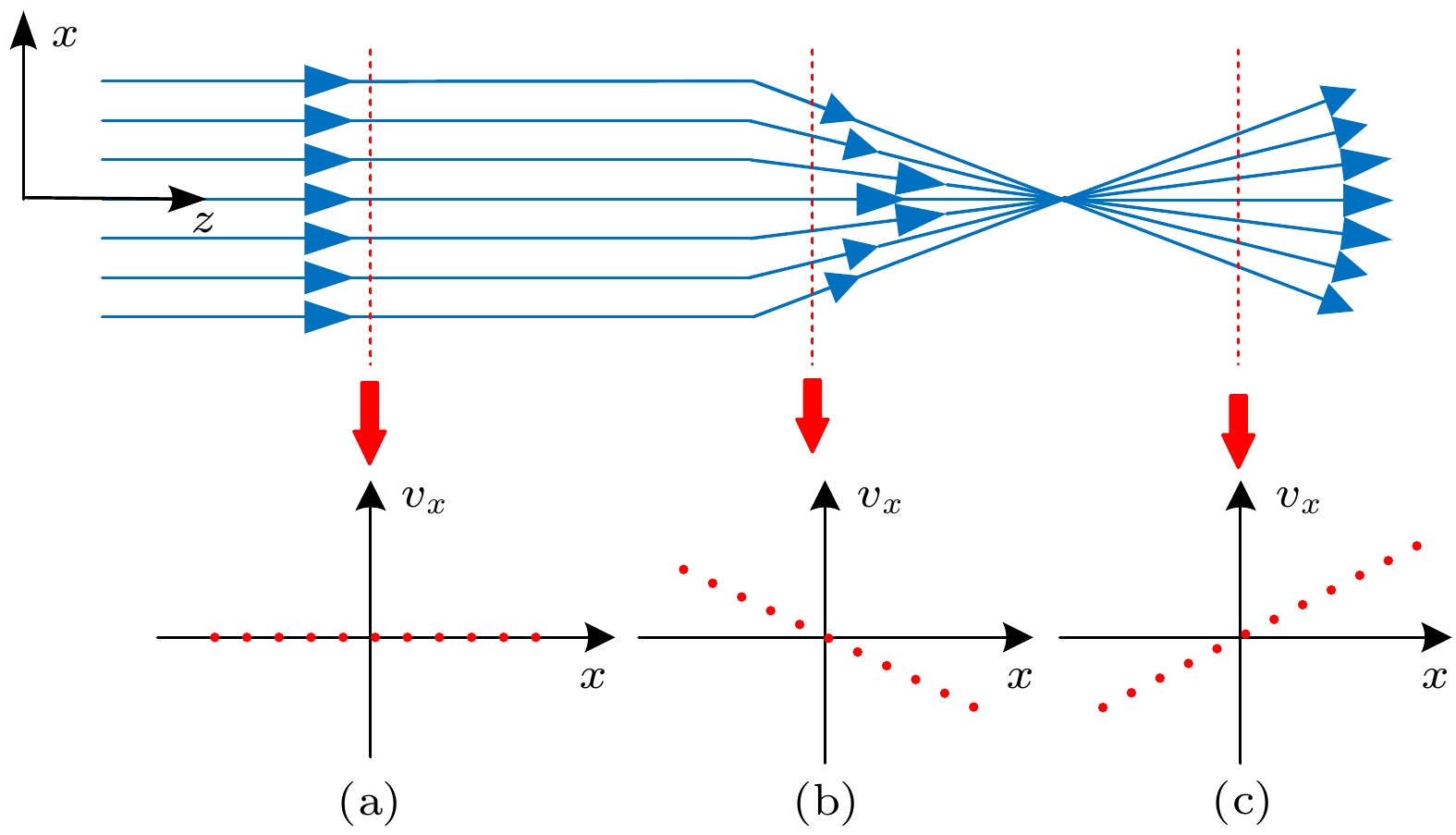
 下载:
下载:
